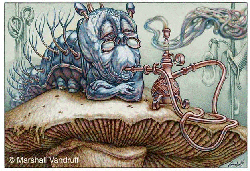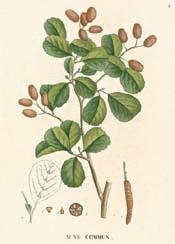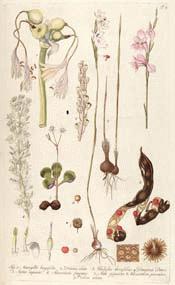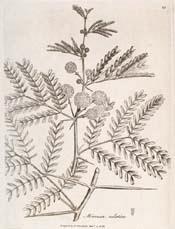
WHOOO
AAARRRE YOOOUUU?
|

WHOOO
AAARRRE YOOOUUU?
|
| (The information on this page was compiled by Aisling from the notes she took in several workshops given by Brie on the properties and uses of oils and plants, which is a Craft specialty of hers. Commentary on Brie's practices are from Aisling's observation. Brie's sources for this material are her own.) |

Alder
| OILS
ANd RESINS
Essential oils are the basis for much formulary magic. In Brie's World, oils are used to create magical incenses, anointing mixtures, ambient scents, ritual bath mixtures, and trance or meditational compounds. Some guidelines for compounding these will follow in other sections of this page. For now, let's concentrate on the character and properties of essential oils. |
| Essential oils by definition are the pure extracts of plant materials. They are produced from the fresh plant material by the process of steam or alcohol distillation and contain no other ingredients. A true "essential oil" is never adulterated with a base oil or any other compound for preservation, dissolution, scent enhancement, or for any other reason. For this reason, essential oils are highly volatile and will evaporate quickly if they are exposed to the air. They also are highly concentrated and some oils will burn the skin if applied directly. |

Chamomile |

Angelica |
| The
chemistry
of essential oils is very complex. There are hundreds of components, such
as terpenes, aldehydes and esters. Because of this an essential oil can
be used to help a wide variety of disorders. As a not unusual example,
essential oil of Lavender has antiseptic, antibacterial, antibiotic, antidepressant,
analgesic,
decongestant and sedative properties. Due to their tiny molecular structure,
essential oils applied to the skin can be easily absorbed into the bloodstream.
One must use caution with all essential oils, since some may be toxic.
a listing
of useful books and articles to inform
oneself about essential oils, incense making and aromatherapy is in the
link above.
Essential Oils also reach the bloodstream as a result of the oils themselves being inhaled. When inhaled, they pass through the tiny air sacs to the surrounding blood capillaries by the process of diffusion. Once in the bloodstream the aromatic molecules interact with the body's chemistry. Aside from their medicinal properties, smelling an essential oil can uplift the spirits, making you feel better. Our sense of smell is interrelated with the limbic system, an area of the brain which is primarily concerned with emotion and memory. This influence of aromas on our psyches has led many aromatherapists to practice a form of aromatherapy called 'psycho-aromatherapy', using essential oils to enhance the moods and emotions. |

Comfrey
| Resins are the sap or gum exuded by the bark of trees, or the sap of woody plants like acacia or Aloe Vera. Resins are the carrier used to make incense mixtures burn slowly and give off pleasant smoke instead of the charred smoke of normal burning. The proportion of resin to other ingredients in an incense mixture is the key to how well it burns and how long-lasting and effective the scent. In creating an incense for magical purposes, both the resin, the flower or wood and the oil must have the same magical attributions in order for the mixture to work successfully. Resins tend to be expensive compared to more common flower and plant products, |
| There are all kinds of sites and books available that give incense "recipes". Brie has more of a tendency to believe, as some people do about cooking, that what is important is not the "recipe" but the "Method". One's own instinct about attributions is always more reliable than anything found in a book or a web site, which are, after all, all someone ELSE'S experiences. Therefore, in creating essentiial oil blends or incenses, or indeed any other mixture, for magical purposes, the first question to be asked is "What is the desired result?" Then one asks, "What are some plants, herbs, or oils which I believe contain that energy?" After that, the decisions about what to use often depend on availability and affordability of ingredients. There is, in Brie's belief, no ingredient that has no substitute, with the possible exception of essential rose oil, for which nothing else seems to serve. Attempting to create an incense with a particular scent is usually an unsuccessful proposition since not all ingredients used to achieve a certain magical purpose smell good when combined. However, when the magical purposes of each ingredient in the blend are carefully considered in compounding the mixture, the scent achieved will either be extremely pleasant or, at worst, acceptable. |

Dragonsblood |

Acacia |
| It is very important to remember that the information and suggestions above apply to making of magical blends only. Medicinal aromatherapy is much more dependent upon the published work of scientists and herbalists, including medical professionals, to ascertain what remedies suit what ailments and what herbs and oils are harmless when used together. This field is not a specialty in Brie's personal priestess work. For this reason medicinal herbalism is not being discussed on this site. PLease consult a medical professional or certified herbologist if you are interested in this work. |

Mountain Aster
| INCENSE
FORMULAry
A basic Magical incense can be achieved by as simple a process as dropping a few drops of essential oil on a burning charcoal briquet. (IMPORTANT: The charcoal to be used here is NOT to be cooking charcoal, which gives off several poisonous gases, including carbon monoxide. Use the special charcoal manufactured specifically for burning incense. Sources for ordering this are here. Sometimes, however, a complex pattern of magical energies is desired. Here are several methods for producing these. It is important to realize that the proportions of types of ingredients are what makes a particular incense mixture work well insofar as how it burns, (or IF it burns) , for how long, and what scent and other energies it gives off. The actual ingredients to be used are mutable at the Will of the practitioner. Basic Incense Method: ("Parts" here refers to actual physical quantities. "A piece the size of a peanut" is a good starting quantity.) 2
parts resin
Begin with your resin. (NOTE on Resins: Brie suggests copal as an all-purpose resin, and uses it almost exclusively because of its light and nonpervasive scent. She cautions that more commonly used resins, such as frankincense, myrrh and benzoin, have somewhat overpowering scents that will direct the scent of your mixture.) Grind it as fine as you can before adding any other ingredients, (Brie always uses mortar and pestle onlyto mix and make incenses, although certain very woody ingredients may either be bought ground or machine-ground before beginning to make the incense) Resins will be sticky and have a consistency like crystallized honey, so this process is likely to take some time. Be sending the energy of your desired result for the compound whilst you are grinding. When the resin is ground as finely and evenly as you can manage, begin gradually adding flower or wood parts to the resin, a little at a time. If you are using both flower and wood parts, add the wood first, working from densest to lightest ingredients including the resin. Total proportion of ALL other ingredients should generally be no more than half again as much as your amount of resin. After adding each portion of flower or wood products, grind into and with the resin until you again arrive at a uniform consistency before adding the next portion. The mixture should be somewhat drier than was the resin by itself. When the ingredients above are added satisfactorily, begin adding essential oils. Brie usually uses blends of essential oils that she has decided upon for their numerological and magical properties. (I.e. a certain number of drops of a particular oil possessing a particular magical attribution.) If the same blend is to make an incense and another product (such as an anointing oil) the number of drops of each oil decided upon is mixed ahead of time and then drops of the blend are added to the mixture. If only an incense is to be made, the appropriate number of drops of each ingredient to be used are decided on paper and then oils are added in the proper quantities, one variety at a time. The most important function of the essential oil besides its magical use, is to add as a vehicle to carry the scent, the energy, and the physical smoke into the atmosphere, since the combination of resin and oil are what gives any particular incense its character. A
good incense has the consistency of an art-gum eraser or soft, chewy brownies.
When your mixture is approaching this consistency, pinch off a piece and
begin testing it on a burning charcoal for consistency, scent and duration.
essential oils may be added to adjust the quality of the incense. Incense
burns better if it is not used immediately but has a chance to age. This
mixes and mellows the scent but should not be a time during which the incense
dries out. Keep the mixture tightly capped after it does age. If
it becomes dusty or crumbly, reconstitute with drops of essential oil before
burning.
(After taking Brie's first workshop, I went searching and found several ancient incense recipes. These are included here to show varieties in technique and ingredients. I have since made several incenses using spirits or wine, and fruit, as ingredients and liked the results.)
Ancient Incense Recipes
Amount (In Parts)
Ingredient
Thoroughly grind
all ingredients separately, then mix together groups of ingredients by
nature: resinous together, powdery together, etc. Finally, mix all batches
together, add red wine to moisten, then roll into 5/8" balls and roll balls
in benzoin. Lay out on waxed paper for a week or so, until firm.
2 Parts Copal
Use the general
incense formulary above to make this. This blend is used to banish unwanted
energies from a space where one intends to do sacred workings, and to frighten
away ghosts and evil spirits.
Blessing Sticks Three sticks
of common sage
Peel the willow wand, and cut it to be about three inches longer than the aromatic sticks. Bind the nine sticks of aromatics around the willow wand so that the three inches (or more if you like) protrudes at one end to use as a handle, using the sweetgrass or raffia to bind the twigs together. Hang upside daown in a cool dark place until all the herbs are dry, and use like a smudge stick to cleanse and bless sacred space. If you would rather not burn your blessing stick, it can be used as an asperging wand to cleanse and bless with salt water
A
Word About Oils
Oils are the central focus of all aromatherapy, so it is well to know some basic information about them before beginning to use them. All oils are NOT created equal. In your shopping for ingredients to use in making incenses, anointing oils, aromatics, bath products and limbic enhancers, you may find yourself bewildered by the array of products out there.and spend a lot of money on the wrong thing. In your work, you should be aware of the following differences: 1. Essential Oils: These are the workhorse of the herbalist/aromatist, and have the widest array of uses. They are also very expensive and are sold (and used) in small quantities. Essential oils are PURE, having no additives. Sometimes one may see mixtures of several essential oils, sold under a blend name. This is rare, and a reputable oil dealer will accomodate your desire to buy your oils in single unmixed quantities. Otherwise, you run the risk of inadvertently buying 2. Perfume Oils: These are essential oils mixed with a base oil, alcohol, or both. This is done to make it possible for the oil to be safely applied to the skin, and also in order to preserve the scent (essential oils are very fragile and sometimes can spoil if not kept properly) They are seldom labeled with ingredients, and, if used for the same purposes as essential oils, can produce unpredictable, and sometimes unsatisfactory, results. Particularly, perfume oils should not be burned, as they are either not flammable at all, or may be mixed with alcohol which will give them an unpleasant scent and may emit toxic fumes or catch fire. 3.Blended Intention Oils: Some (many) dealers in oils and other herbal products create blends that are intended to be used for magical purposes as they are created, such as "Energy Oil" or "Prosperity Oil". These oils can be useful if they are labeled with the ingredients used in their formulation, as well as proportions thereof. But most of them are not, because the makers have proprietary formulae they do not want consumers to be able to reproduce on their own. This results in the user of such oils not being able to check to see whether the ingredients used resonate with their own sense of the magical nature of the ingredients, not to mention perhaps exposing one to an oil to whose ingredients one may be sensitive or allergic. It is not difficult to create your own intentino oils using a base oil and your own choice of essential oils. |
| Resins | Woods | Herbs |
(# indicates a Base Oil) |
| Amber
Aloe Benzoin - Siam Benzoin - Sumatra Borneol Camphor Copal - Gold Copal - Black (Copal is a favorite of Brie's She tells me there are many different kinds of copal based on where it is harvested. Search out alternate kinds and experiment.) Dragon's Blood Frankincense Myrrh
|
Aspen
Birch Bark Cedar Cinnamon bark Clove buds Juniper Oakwood Rosewood Rowan Sandalwood Spruce Pine |
Chamomile
Ginger Henna Hyssop Iris Irish Moss Juniper Lavender Lemongrass Lilac Marjoram Mint Mistletoe Mugwort Patchouli Rose Rosemary Sage Star Anise Sweet Grass Thyme Vanilla Verbena Violet
|
#Almond
(sweet)
Basil Bergamot Birch Black Pepper Cedarwood Chamomile Cinnamon Clary sage Clove #Corn Cypress Eucalyptus Fir Frankincense Geranium Grapefruit #Grapeseed Jasmine Juniper Lavender Lilac Lemon Lemongrass Marjoram Myrrh Neroli Nutmeg #Olive Orange Oregano Parsley Patchouli Rose Essence Rose Geranium Rosemary Rose Otto #Safflower Sandalwood Spruce #Sunflower Tangerine Tea Tree Thyme Vanilla Vetiver Ylang-Ylang |
| A note about flowers and herbs: Nearly any blooming flower can be used to make incense. Leaves, roots, seedpods, buds, petals, berries and any other plant parts are appropriate. The most important thing about selecting ingredients is to go with your own personal set of correspondences for magical energy. The herbs and flowers in the above list are a SMALL SAMPLING of ingredients Brie has used successfully. The only reason to do more than "go with your gut" on this one, is that some flowers stink, and some, especially traditional "witchy" types of plants, can be highly toxic, even when only touched, let alone burned. It is very important to know your ingredients, especially if you are gathering your incense materials or growing them instead of buying them from an herb dealer. Do not guess about the nature of any substance you intend to apply topically, inhale, bathe in or with, burn, or ingest. The link above has some excellent herbal references through which you may research plants before making choices. |
Scent
Sense
Sacred
oils